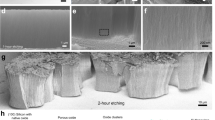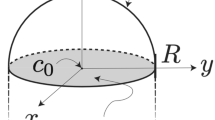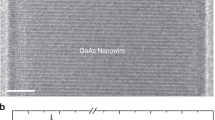Abstract
Self-assembled nanowires offer the prospect of accurate and scalable device engineering at an atomistic scale for applications in electronics, photonics and biology. However, deterministic nanowire growth and the control of dopant profiles and heterostructures are limited by an incomplete understanding of the role of commonly used catalysts and specifically of their interface dynamics1,2. Although catalytic chemical vapour deposition of nanowires below the eutectic temperature has been demonstrated in many semiconductor–catalyst systems3,4,5,6, growth from solid catalysts is still disputed and the overall mechanism is largely unresolved. Here, we present a video-rate environmental transmission electron microscopy study of Si nanowire formation from Pd silicide crystals under disilane exposure. A Si crystal nucleus forms by phase separation, as observed for the liquid Au–Si system, which we use as a comparative benchmark. The dominant coherent Pd silicide/Si growth interface subsequently advances by lateral propagation of ledges, driven by catalytic dissociation of disilane and coupled Pd and Si diffusion. Our results establish an atomistic framework for nanowire assembly from solid catalysts, relevant also to their contact formation.
This is a preview of subscription content, access via your institution
Access options
Subscribe to this journal
Receive 12 print issues and online access
$259.00 per year
only $21.58 per issue
Buy this article
- Purchase on Springer Link
- Instant access to full article PDF
Prices may be subject to local taxes which are calculated during checkout



Similar content being viewed by others
References
Wagner, R. S. in Whisker Technology (ed. Levitt, A. P.) (Wiley, New York, 1970).
Hiruma, K. et al. Growth and optical properties of nanometer-scale GaAs and InAs whiskers. J. Appl. Phys. 77, 447–462 (1995).
Kamins, T. I., Williams, R. S., Basile, D. P., Hesjedal, T. & Harris, J. S. Ti-catalyzed Si nanowires by chemical vapor deposition: Microscopy and growth mechanisms. J. Appl. Phys. 89, 1008–1016 (2001).
Persson, A. I. et al. Solid-phase diffusion mechanism for GaAs nanowire growth. Nature Mater. 3, 677–681 (2004).
Wang, Y. W., Schmidt, V., Senz, S. & Gosele, U. Epitaxial growth of silicon nanowires using an aluminium catalyst. Nature Nanotechnol. 1, 186–189 (2006).
Kodambaka, S., Tersoff, J., Reuter, M. C. & Ross, F. M. Germanium nanowire growth below the eutectic temperature. Science 316, 729–732 (2007).
Park, H. D., Gaillot, A.-C., Prokes, S. M. & Cammarata, R. C. Observation of size dependent liquidus depression in the growth of InAs nanowires. J. Cryst. Growth 296, 159–164 (2006).
Adhikari, H., Marshall, A. F., Chidsey, C. E. D. & McIntyre, P. C. Germanium nanowire epitaxy: Shape and orientation control. Nano Lett. 6, 318–323 (2006).
Howe, J. M. Interfaces in Materials (Wiley, New York, 1997).
Jackson, K. A. The present state of the theory of crystal growth from the melt. J. Cryst. Growth 24–25, 130–136 (1974).
Hannon, J. B., Shenoy, V. B. & Schwarz, K. W. Anomalous spiral motion of steps near dislocations on silicon surfaces. Science 313, 1266–1269 (2006).
Mangin, P., Marchal, G., Mourey, C. & Janot, C. Physical studies of Au(x)Si(1-x) amorphous alloys. Phys. Rev. B 21, 3047–3056 (1980).
Shpyrko, O. G. et al. Surface crystallization in a liquid AuSi alloy. Science 313, 77–80 (2006).
Baxi, H. C. & Massalski, T. B. The Pd–Si System. J. Phase Equilib. 12, 349–356 (1991).
Hofmann, S. et al. In situ observations of catalyst dynamics during surface-bound carbon nanotube nucleation. Nano Lett. 7, 602–608 (2007).
Wu, Y. et al. Controlled growth and structures of molecular-scale silicon nanowires. Nano Lett. 4, 433–436 (2004).
Cherns, D., Smith, D. A., Krakow, W. & Batson, P. E. Electron-microscope studies of the structure and propagation of the Pd2Si-(111)Si interface. Phil. Mag. A 45, 107–125 (1982).
Rubloff, G. W. Microscopic properties and behavior of silicide interfaces. Surf. Sci. 132, 268–314 (1983).
Kodambaka, S., Tersoff, J., Reuter, M. C. & Ross, F. M. Diameter-independent kinetics in the vapor–liquid–solid growth of Si nanowires. Phys. Rev. Lett. 96, 096105 (2006).
Liau, Z. L., Campisano, S. U., Canali, C., Lau, S. S. & Mayer, J. W. Kinetics of the initial stage of Si transport through Pd-silicide for epitaxial growth. J. Electrochem. Soc. 122, 1696–1699 (1975).
Goesele, U. in Alloying (eds Walter, J. L., Jackson, M. R. & Sims, C. T.) (ASM, Ohio, 1988).
Lee, S. W., Jeon, Y. C. & Joo, S. K. Pd induced lateral crystallization of amorphous Si thin-films. Appl. Phys. Lett. 66, 1671–1673 (1995).
Hesse, D., Werner, P., Mattheis, R. & Heydenreich, J. Interfacial reaction barriers during thin-film solid-state reactions—the crystallographic origin of kinetic barriers at the NiSi2/Si(111) interface. Appl. Phys. A 57, 415–425 (1993).
Frank, F. C. The influence of dislocations on crystal growth. Discuss. Faraday Soc. 5, 48–54 (1949).
Landolt-Bornstein (ed.) Diffusion in Semiconductors III/33 (Springer, Berlin, 1998).
Weber, W. M. et al. Silicon-nanowire transistors with intruded nickel-silicide contacts. Nano Lett. 6, 2660–2666 (2006).
Saka, H., Sasaki, K., Tsukimoto, S. & Arai, S. In situ observation of solid–liquid interfaces by transmission electron microscopy. J. Mater. Res. 20, 1629–1640 (2005).
Sharma, R. An environmental transmission electron microscope for in situ synthesis and characterization of nanomaterials. J. Mater. Res. 20, 1695–1707 (2005).
Yokota, T., Murayama, M. & Howe, J. M. In situ transmission-electron-microscopy investigation of melting in submicron Al–Si alloy particles under electron-beam irradiation. Phys. Rev. Lett. 91, 265504 (2003).
Acknowledgements
S.H. acknowledges funding from Peterhouse, S.H. and C.D. from the Royal Society. F.C.-S. acknowledges CONACyT Mexico.
Author information
Authors and Affiliations
Corresponding author
Rights and permissions
About this article
Cite this article
Hofmann, S., Sharma, R., Wirth, C. et al. Ledge-flow-controlled catalyst interface dynamics during Si nanowire growth. Nature Mater 7, 372–375 (2008). https://doi.org/10.1038/nmat2140
Received:
Accepted:
Published:
Issue Date:
DOI: https://doi.org/10.1038/nmat2140
This article is cited by
-
Catalyst-free synthesis of sub-5 nm silicon nanowire arrays with massive lattice contraction and wide bandgap
Nature Communications (2022)
-
In situ analysis of catalyst composition during gold catalyzed GaAs nanowire growth
Nature Communications (2019)
-
Recent advances in gas-involved in situ studies via transmission electron microscopy
Nano Research (2018)
-
Synthesis and characterization of ultralong SiC nanowires with unique optical properties, excellent thermal stability and flexible nanomechanical properties
Scientific Reports (2017)
-
Probing the growth and melting pathways of a decagonal quasicrystal in real-time
Scientific Reports (2017)



